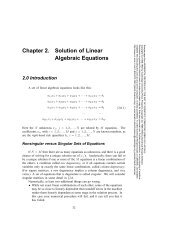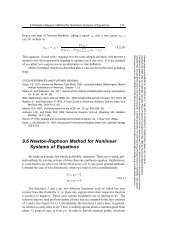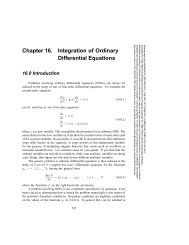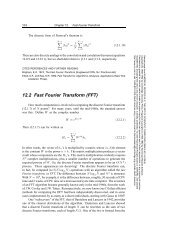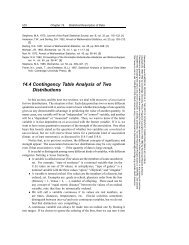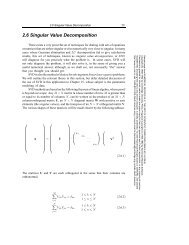12 Distributed Transactions
12 Distributed Transactions
12 Distributed Transactions
You also want an ePaper? Increase the reach of your titles
YUMPU automatically turns print PDFs into web optimized ePapers that Google loves.
<strong>12</strong> <strong>Distributed</strong> <strong>Transactions</strong>• Models for distributed transactions• Attaining distributed commitment• <strong>Distributed</strong> Concurrency Control<strong>12</strong>.1 Single Server <strong>Transactions</strong>transaction 1client1Transaction Managerclient2 transaction 2serverresourceclientNtransaction N• Till now, transactions have referred to multiple clients, single server.• How do we have multiple clients interacting with multiple servers? eg complicatedfunds transfer involving different accounts from different banks?• Generalise transactions to distributed case...<strong>12</strong>.2 <strong>Distributed</strong> <strong>Transactions</strong><strong>12</strong>.2.1 <strong>Distributed</strong> Transaction RequirementsGeneral characteristics of distributed systems• Independent Failure Modes• No global time• Inconsistent StateNeed to consider:• how to achieve distributed commitment (or abort)• how to achieve distributed concurrency control1
<strong>12</strong>.2.2 ModelsclientXYclientTZT1XT11MT<strong>12</strong>NZT2YT21T22PSimple <strong>Distributed</strong> modelNested Transaction• If client runs transactions, then each transaction must complete before proceedingto next• If transactions are nested, then transactions at same level can run in parallel• Client uses a single server to act as coordinator for all other transactions. Thecoordinator handles all communication with other serversQuestion: What are the requirements of transaction ids?<strong>12</strong>.3 Atomic Commit Protocols• Distribution implies independent failure modes, ie machine can fail at anytime, and others may not discover.• If one phase commit, client requests commit, but one of the server may havefailed - no way of ensuring durability• Instead, commit in 2 phases, thus allowing server to request abort.<strong>12</strong>.3.1 2 Phase Commit• One coordinator responsible for initiating protocol.• Other entities in protocol called participants.• If coordinator or participant unable to commit, all parts of transaction areaborted.• Two phasesPhase 1 Reach a common decisionPhase 2 Implement that decision at all sites2 Phase Commit Details1. Phase 1 The coordinator sends a Can Commit? message to all participantsin transaction.2. Participants reply with vote yes or no. If vote is no participant aborts immediately.2
3. Phase 2 Coordinator collects votes including own:(a) If all votes are yes, coordinator commits transaction and sends DoCommitto all participants.(b) Otherwise transaction is aborted, and coordinator sends abortTransactionto all participants.4. When a participant recieves DoCommit, it commits its part of the transactionand confirms using HaveCommitedcoordinator1. Prepared to commit(waiting for votes)CanCommit?Yesparticipant2. Prepared to commit(uncertain)3. Committed(or aborted)DoCommit5. DoneHaveCommitted4. Commit2 Phase Commit Diagram Note:• If participant crashes after having voted to commit, it can ask coordinatorabout results of vote.• Timeouts are used when messages are expected.• Introduces new state in transaction Prepared to commit.<strong>12</strong>.4 <strong>Distributed</strong> Concurrency Control<strong>12</strong>.4.1 Locking• Locking is done per item, not per client.• No problems generalising to multiple servers...• ...except in dealing with distributed deadlock• Same techniques as usual, but interesting dealing with distributed deadlockdetection.<strong>12</strong>.4.2 Optimistic Concurrency Control• Need to worry about distributed validation• Simple model of validation had only one transaction being validated at atime - can lead to deadlock if different cordinating servers attempt to validatedifferent transaction.3
• Also need to validate in correct serialisable order.• One solution is to globaly only allow one transaction to validate at a time.• Other solutions is to validate in two phases with timestamp allocation - local,then global to enforce ordering.<strong>12</strong>.4.3 Timestamping• If clocks are approximately synchronised, then timestamps can be< localtimestamp, coordinatingserverid >pairs, and an ordering defined upon server ids.<strong>12</strong>.5 Summary• Nested <strong>Transactions</strong> are best model for distributed transactions• Two Phase Commit protocol suitable for almost all case• <strong>Distributed</strong> Concurrency control is only slightly more diffcult than for singleserver case4



